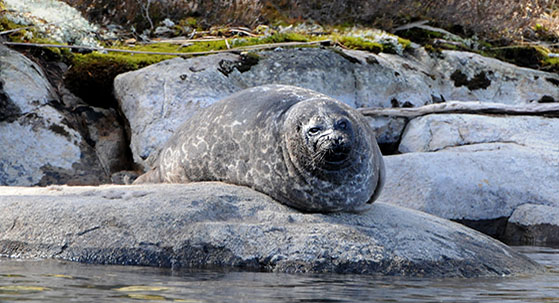Press release 2016-01-25 at 16:36

A critically endangered Saimaa ringed seal lounging on a rock. In 2015, the total winter population was estimated to consist of 320 individuals. Photo by Mervi Kunnasranta.
The number of threatened mammal species decreased by four compared to the previous evaluation. No species were found to be more threatened than before. Conversely, four species, namely the European beaver, the brown bear, the Eurasian lynx and the Siberian flying squirrel, were re-categorised from threatened to near threatened. Two species that had previously been categorised as near threatened, namely the mountain hare and the European otter, were removed from the Red List.
The evaluation of threatened mammal species conducted in 2015 encompassed 75 species and subspecies found in Finland. The Red List category of 51 of these species remained unchanged. Eight species were re-categorised as less threatened, while no species were found to be more threatened than in the previous evaluation. Sixteen species were deemed ineligible for assessment (due to being alien species or vagrant visitors). The two subspecies of the ringed seal (the Baltic ringed seal and the Saimaa ringed seal) and the two subspecies of the reindeer (the Eurasian tundra reindeer and the Finnish forest reindeer) were assessed individually.
Threat from hunting, climate change and random factors
There are seven mammal species found in Finland that are categorised as threatened: the arctic fox (critically endangered), the Saimaa ringed seal, the wolverine, the gray wolf and the Natterer’s bat (endangered) as well as the Nathusius’ pipistrelle and the European polecat (vulnerable). In addition to this, the Siberian flying squirrel, the Eurasian beaver, the common vole, the brown bear, the Eurasian lynx, the Baltic ringed seal and the Finnish forest reindeer are categorised as near threatened. Two species, the mountain hare and the European otter, were re-categorised as species of least concern and thus removed from the Red List.
The most common causes of mammal species becoming threatened include hunting (both legal and illegal as well as legal bycatch) and random factors related to small population sizes. In addition to this, climate change also plays a part in the decline of the arctic fox, the mountain hare, the Saimaa ringed seal and the Baltic ringed seal.
Forest management and changes in the structure of forests are considered to threaten only two species in Finland, namely the Siberian flying squirrel and the Finnish forest reindeer. Other individual factors threatening mammals include disturbance, interspecies competition, cross-breeding, genetic problems, predation and pollutants.
Protection as well as conservation and management plans contributing to the growth of mammal populations
Of the animal conservation methods employed in Finland, the practice of designating species as protected is considered the most effective and comprehensive in regard to population coverage. In Finland, all species not specifically listed as game species or unprotected species in the Hunting Act are considered protected. Provisions on the protection of game animals are provided in the Hunting Act. A good example of the effects of protection is the European otter, which was designated as protected in 1974. The resulting end of otter hunting together with the restoration of water bodies is considered the main cause of the species' recovery.
Finland has prepared conservation and management plans for several mammal species. These plans are needed when there are several operators involved in the implementation of conservation or management measures or when these measures have an impact on people's business and recreational activities. The current management plans also take socioeconomic factors into consideration. In recent years, Finland has prepared new plans and programmes or updated the existing plans and programmes of all large predators, the Finnish forest reindeer, seals, beaver species, the Saimaa ringed seal and the porpoise.
Criteria for threatened species
The evaluation of threatened mammal species in Finland was conducted in 2015 based on the criteria and categorisation of the International Union for Conservation of Nature (IUCN), as were the previous evaluations conducted in 2010 and 2000. By request of the Ministry of the Environment, the assessment work was carried out by an expert group appointed by the Finnish Mammalogical Society. The work was supervised and approved by the Steering Group for Evaluation of Threatened Species (LAUHA).
Threatened species are species that are at risk of becoming extinct in the future. In the evaluation, the risk of extinction of individual mammal species was assessed based on four criteria: reduction of population size, small geographic range, small and continuously declining population or very small or restricted population. Mammal species are most commonly threatened due to having very small or geographically restricted populations.
The risk of extinction can be lowered by identifying the causes contributing to it and enacting measures to address them. Near threatened species included in the Red List are species that do not quite meet the criteria for threatened species, but may become threatened unless measures are taken to prevent it.
More information
Professor Heikki Henttonen, Natural Resources Institute Finland (LUKE),
tel. +358 (0)29 532 2430, firstname.lastname@luke.fi
Environment Counsellor Esko Hyvärinen, Ministry of the Environment,
tel. +358 (0)295 250 094, esko.o.hyvarinen at ymparisto.fi
Senior Researcher Ulla-Maija Liukko, Finnish Environment Institute (SYKE),
tel. +358 (0)295 251 387, firstname.lastname@ymparisto.fi